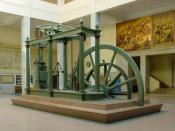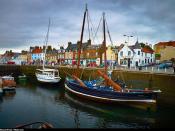Scotland Human Environment Interaction I picked Scotland because it has a lot of history, inventions, and very interesting vegetation.
Scotland has a abundant supply of coal, but mining is not the major industry. Large, newly discovered reserves of crude petroleum are now being exploited in the North Sea, north and east Scotland, as well as west Shetlands, and this industry is bringing new wealth to Scotland's northern ports. Agricultural resources are small: less than 20% of the land is cropland, but more than half is classified for rough grazing. Oats and fodder crops grown, and sheep raising is important. Fishing is the major industry.
Many inventions have come from Scotland such as the Buick, name of a brand of a car that is in U.S.A., there are over 25 million cars. Fax machines came from Scotland too, invented by a blacksmith in Dumfries in the early 19th century.
The Iron Bridges were invented by engineer Thomas Thelford. He was famous for building more than 1,200 bridges. Penicillin was discovered in 1928 by the Bacteriologist, by Sir. Alexander Fleming. The steam engine was invented by James Watt, an instrumental in powering the Industrial Revolution in the 18th century. There are many more inventions that come from Scotland such as the telephone, thermo flask, telegraph, television, whisky, and the breech-loading rifle.
Many of the original forests in Scotland have been cleared for cultivation. In the northern part of the Scotland many lushly wooded areas often called glens are often found there. The abundance of shrubs and flowers found in Scotland include Rhododendrons, Fuchsias, and the famous Scottish Heather. A prickly shrub with brilliant yellow blossoms, called whin in Scotland (Gorse in England) is widely spread. The most common wild berry is the Bramble (Blackberry). There is an abundance of seafood...

![[Edinburgh from the castle, Scotland] (LOC)](https://s.writework.com/uploads/11/117998/edinburgh-castle-scotland-loc-thumb.jpg)
